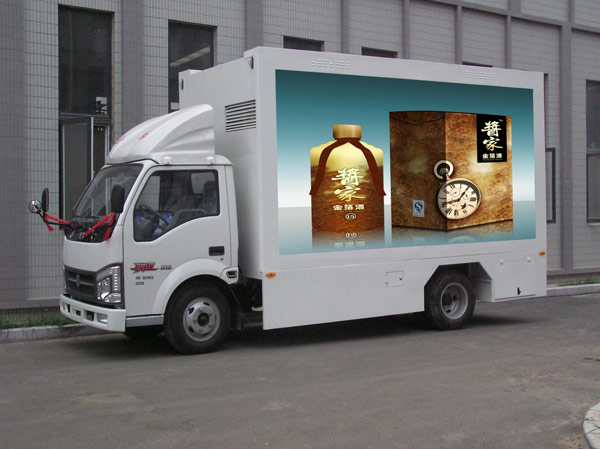The LED mobile advertising vehicle is a new type of advertising device that takes LED display screen as an information output device and takes the mobile body as a carrier in recent years. Due to its convenience, dissemination, novelty, and flexibility, it has gradually become the preferred choice for business partners. Advertising vehicle types. The LED mobile advertising vehicle is mainly composed of five parts: LED display screen, power supply system, hydraulic system, operating system and traction system. The LED display screen is the soul of the LED mobile advertising vehicle. Advertisers use their visual and auditory impact to achieve their propaganda purposes. The body can realize media operation at any place and at any place according to the user's needs, and due to the energy-saving features of the LED, the requirements for the power supply system of the body are not particularly strict. LED mobile advertising vehicles can be interconnected with the Internet, and a full coverage of the city's media publicity network based on demand is one of the advantages that differentiates it from traditional advertising vehicles. Moreover, LED mobile advertising vehicles only advertise through electronic screens, which is different from handing out flyers or propagating advertising posters on advertising screens. It does not cause environmental pollution and is more adaptable to the theme of green development. LED mobile advertising vehicles have the advantages of low-carbon, energy-saving, environmental protection and novel forms. Since its inception, it has been sought after by business owners. Its appearance has changed the advertising publicity model, and people are no longer forced to accept various kinds of helplessness or sympathy. Leaflets either directly ignore huge advertising screens, but they are involuntarily attracted by the picture quality and sound comparable to television standards. They have more advantages in achieving publicity, and LED mobile advertising vehicles are even more cost-effective. Can be played indefinitely, which is not comparable to traditional paper advertisements. The prospect of LED mobile advertising vehicles is very broad. According to the survey, the investment in advertising in China each year amounts to hundreds of billions. According to the current trend, it can be foreseen that LED mobile advertising vehicles will occupy a higher market share and the demand for LED advertising vehicles . The volume will also grow bigger and bigger. Therefore, LED mobile advertising vehicles will usher in unprecedented prosperity. Excavator Cylinder Piston Rod Seals
Installation and application of piston rod seal for excavator hydraulic cylinder Excavator hydraulic cylinder piston rod seal, hydraulic cylinder piston seal, sealing kit Safe Seal Technology Co., Ltd. , https://www.jssafeseal.com
The installation and application of hydraulic cylinder piston rod seals in excavators mainly include the following aspects:
1. Applying lubricating oil: Before installing the seal, the surface of the piston rod must be coated with lubricating oil to facilitate the installation and use of the seal.
2. Install the seal: Install the seal on the piston rod in sequence, taking care not to pinch or bend the seal.
3. Pressing the seal: After installing the seal, special tools need to be used to press the seal tightly to ensure its tightness and stability.
4. Check the sealing effect: After installing the sealing element, it is necessary to check the sealing effect. It can be detected by observing the working status of the hydraulic cylinder or using tools such as leak detectors.
5. Application scenario: The piston rod seal of excavator hydraulic cylinder is mainly used in the hydraulic system of construction machinery such as excavators, loaders, and bulldozers to prevent hydraulic oil leakage and ensure the normal operation of the machine.
In summary, the installation and application of hydraulic cylinder piston rod seals in excavators is a very important part of the hydraulic system, and must be strictly operated in accordance with regulations to ensure the normal operation and safety of the machine.